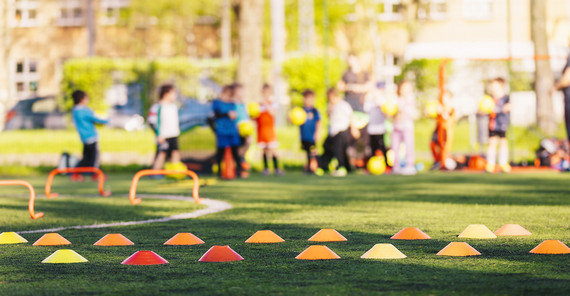Since 2009, 279,756 schoolchildren have taken part in a study that measures their motor fitness. As early as 2006, the Conference of Sports Ministers recommended improving children’s motor fitness. In 2010, the Standing Conference of the Ministers of Education and Cultural Affairs supported this recommendation on the condition that political decisions be based on reliable data. This is exactly where EMOTIKON comes in. All third-graders in the Federal State of Brandenburg go through six tests in physical education – without the pressure of achieving good grades. This may explain why many children primarily enjoy trying a “one-leg stand” in this setting or seeing how far they can push a medicine ball.
Each child receives their “fitness pass” at the latest with their half-year reports. If they perform very well, they also receive a talent pass and an invitation to participate in one of the state-wide talent events. “Receiving such an invitation sometimes means a great deal to the children. We keep getting feedback from parents who tell us how proud their children are and that it was the best school experience ever for them,” explains project manager Dr. Kathleen Golle. The State Sports Association and its district and city sports associations now organize 30 of these talent events every year.
Supporting the less athletic
“EMOTIKON has provided important results for exercise promotion programs since it was launched,” explains Paula Teich, who coordinates the project. “It can be seen as an early warning system that uses comprehensive data to visualize where there is a need for action in the area of motor fitness. Differences can be seen, for example, in the social structure of the schools. At schools with a particularly large number of children from socially disadvantaged families, endurance performance is lower.” EMOTIKON initially requires more effort from the physical education teachers. So there was a lot of skepticism at schools, especially in the beginning: What’s the point of entering data into the software? That has changed. After all, teachers also benefit, and they can use the statistics generated in the project to see where a child stands in comparison to the normal range and where someone is performing much better: a real talent. However, the results can also indicate a lack of development and a need for support, which require motivating and low-threshold exercise programs.
This is also reported by Christoph Schneegass, who teaches sports at a primary school. “When we do the tests for EMOTIKON, it’s a great, special day for most children. Then the gym is used exclusively for this and the lessons are reorganized accordingly. The children can spend the day competing in the exercises – without any pressure to achieve particular grades,” he says. “But there are always children who I can hardly get to move. Those who have problems with simple exercises and, even in the third grade, are unable to do a forward roll. A comprehensive sports promotion program is needed here,” Schneegass says. He would like to see the special talent events offered not only for the “talented”, i.e., those with good motor skills, but for all children - so that they can try out the wide range of sports and find something they enjoy. From the teacher’s point of view, the joy of sport should be given greater consideration anyway. “If we can manage a two-pronged approach and challenge and encourage in equal measure, then we would already have achieved a lot,” the teacher says.
Early warning system for a “moving” future
Research also focuses on the aspect of motivation. Many sports teachers report that most children have an incredible desire to move in class and during the tests. Data shows, however, that it is not possible to maintain this motivation until puberty and beyond. While the project has revealed interesting findings, it cannot provide the coveted panacea. For this, everyone is needed. "For me, EMOTIKON is a successful example of social cooperation, which is needed more than ever," says Reinhold Kliegl. "With this project, we are achieving constructive cooperation between schools, politics, civil society, and science. It is also important to have a stimulating and varied motor environment outside the school." The EMOTIKON early warning system works, and it is loud and clear. But the big challenge will be to take all children along and lead them into a “moving” future. Neither parents nor teachers can do this alone. "We need concerted action by parents, teachers, schools, ministries, the state sports association, sports clubs, and science," Prof. Kliegl says. “We would certainly set an example internationally with this.” At the national level, the Brandenburg “EMOTIKON concept” has already made a name for itself.
Further Information on EMOTIKON:
www.uni-potsdam.de/de/emotikon/index
Reinhold Kliegl has been a Senior Professor of Psychology at the University of Potsdam since 2019.
Dr. Kathleen Golle has been a Research Associate at the Division of Training and Movement Science of the University of Potsdam since 2012.
Paula Teich has been the Coordinator of the EMOTIKON project since 2022.
This text was published in the university magazine Portal – One 2025 “Children” (PDF).



